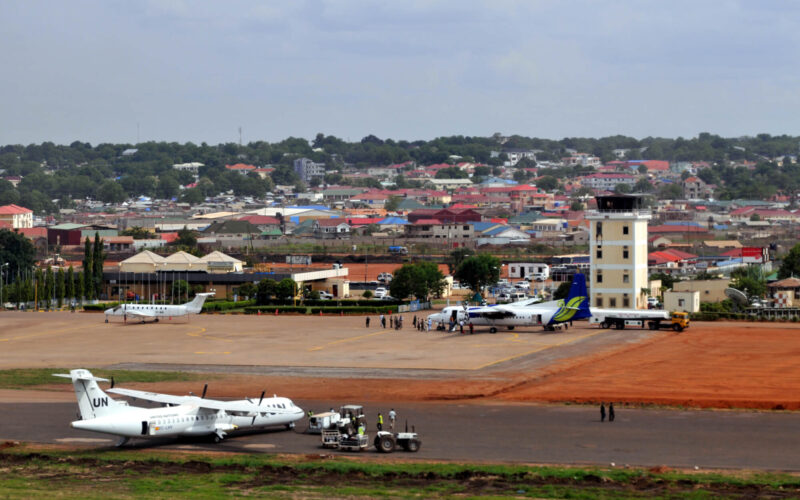Africa is not the easiest region to operate in when it comes to ease of transportation. Journeys to different locations on the vast continent can be hampered by lack of ground transportation infrastructure, insufficient commercial airline routes and, in some areas, safety and security concerns. Rainy season also brings its own problems that have to be taken into account.
That can present additional challenges for the aid organizations which operate on the continent. Often the areas that require the most urgent help are inaccessible by road and aren’t served by commercial air services.
So how do these organizations use aviation to carry out their crucial work saving lives in Africa? How do the aid workers get food, medicine and other supplies to areas that have been cut off by natural disasters or conflict?
One way is thanks to The United Nations Humanitarian Air Service (UNHAS), which is part of a logistics cluster run by the World Food Programme (WFP).
UNHAS offers passenger and light cargo transport for the humanitarian community, providing transport to and from areas of crisis. According to its report for 2020, published in June 2021, UNHAS operates more than 100 aircraft and serves over 400 regular destinations in 24 countries.
In operation for more than 40 years, UNHAS has transported over 2.5 million passengers since 2013, and provides services predominantly in Africa, including Libya, Nigeria, Somalia, South Sudan, and the Democratic Republic of Congo.
Doctors Without Borders
UNHAS is a service used by Médecins san Frontières (Doctors Without Borders), among other organizations. AeroTime spoke to Anwar Sadat, field support advisor for logistics at MSF, to learn more about how the organization uses UNHAS and other air services for its operations in South Sudan.
Most recently, Sadat has been helping to coordinate the response to the devastating floods in South Sudan in 2021. The floods, described as the worst in over 60 years, affected more than 800,000 people, impacting essential services, food supply and drinking water.
“If it’s an emergency, it’s all about timing. The first 72 hours is crucial. That’s why we need charter aircraft,” Sadat says.
MSF has three big international supply centers – in Amsterdam, Bordeaux and Brussels. Staff usually fly to Kenya from Europe and then to the South Sudan capital Juba using commercial services. From there is when things get trickier and MSF has to use other aviation services.
Typically, MSF uses three Cessna Caravans in South Sudan for regular flights to different locations, whether to transport people or goods. It also charters larger aircraft in Juba, such as Fokker or Dorniers, for bigger cargo jobs, and uses the UN logistics cluster. MSF staff use their knowledge and expertise from work on the ground to help brief pilots, and the charter companies that MSF uses are subject to regular audits to ensure high levels of safety.
During the recent flooding, MSF deployed helicopters for three weeks to reach areas that were cut off and where aircraft were no longer able to land.
Air transport also helps to save lives by ensuring faster transport of people needing hospitalization and surgery.
“It’s a crucial factor for us, especially in a country like South Sudan. Without aircraft, we just can’t move,” Sadat says.
Clearing the airstrip
Sadat recounts his first experiences of working for MSF in South Sudan back in 2007, taking off in the Cessna Caravan from Lokichogio in Kenya, where MSF kept goods, medicines and supplies for distribution to South Sudan.
One of the biggest challenges was flying during rainy season, because it can mean airstrips becoming flooded with little notice and therefore no longer available for landing.
“The weather could change really quickly,” Sadat explains. “Before taking off we would have radio contact with the destination to ask about the weather, whether we could land there and they would say yes. Then an hour after taking off, it’s changed.”
The changing seasons also mean different transport links once planes have landed, Sadat says. During rainy season, it’s better to use boats for onward transportation, but in dry season, when the rivers shrink to nothing, goods need to be loaded onto cars.
All pilots check the runway is clear before landing. In South Sudan in 2007, it sometimes wasn’t, according to Sadat. People and cattle were often to be found crossing the runway if airstrips were unguarded.
“Sometimes we couldn’t land immediately and had to wait for teams on the ground to secure the area.”
Things have changed since then, becoming more organized, Sadat says, However, that can also bring some issues. “You need to talk to a lot of people sometimes to deploy a helicopter. And sometimes you need one more signature and that person isn’t there.”
Overall, it’s clear that aviation is a big help to those organizations providing aid to those in need across Africa.
As Sadat tells AeroTime: “If we didn’t have air services, we couldn’t operate.”

